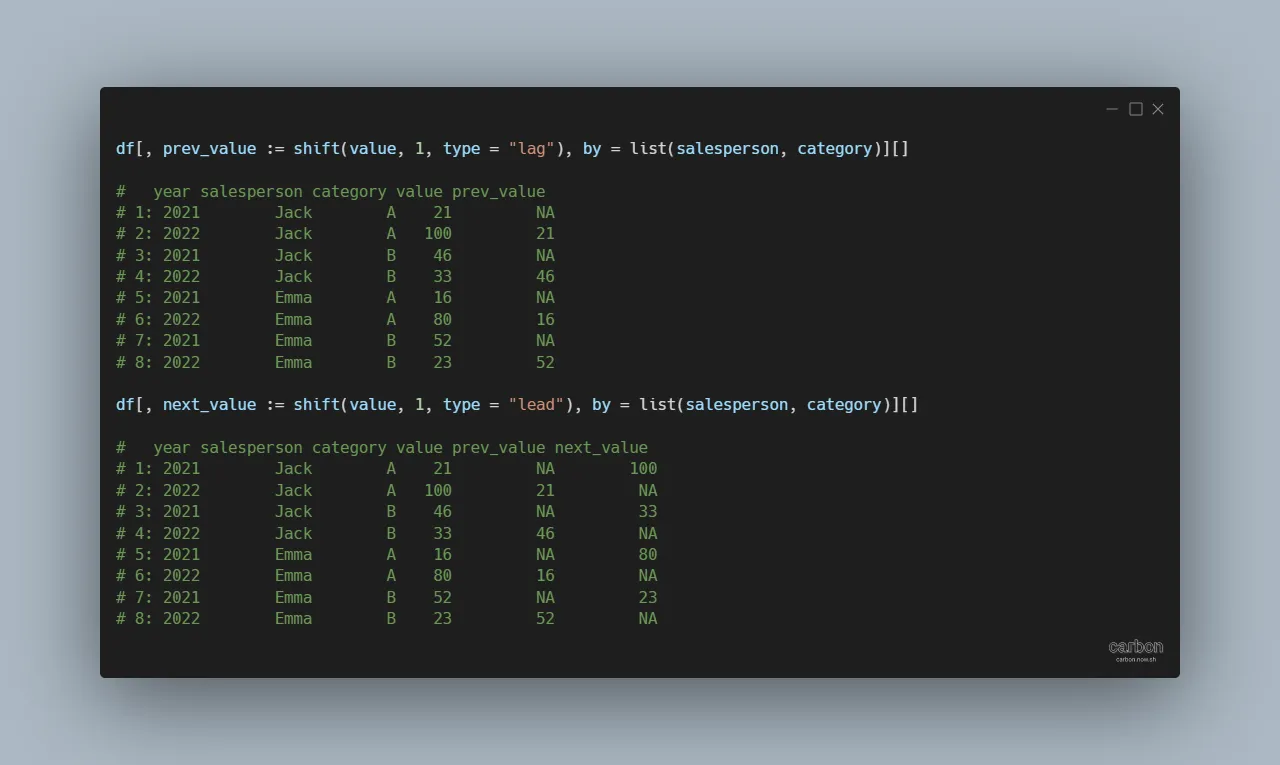If you are working with large datasets and want to get value from the next or previous row in R, try to use the data.table. It is possible to do the same with base R or dplyr, but it might be too slow. Basically, this approach with the data.table to get value from the next or previous row in R is useful to do that fast.
Here is my data set. The code for this dataset might look a little clunky, but if you have a table in Excel, it is easy to copy that into R and transform the data frame into reproducible code.
df <- structure(list(year = c(2021L, 2022L, 2021L, 2022L, 2021L, 2022L, 2021L, 2022L),
salesperson = c("Jack", "Jack", "Jack", "Jack",
"Emma", "Emma", "Emma", "Emma"),
category = c("A", "A", "B", "B", "A", "A", "B", "B"),
value = c(21L, 100L, 46L, 33L, 16L, 80L, 52L, 23L)),
class = "data.frame", row.names = c(NA, -8L))
df
# year salesperson category value
# 1 2021 Jack A 21
# 2 2022 Jack A 100
# 3 2021 Jack B 46
# 4 2022 Jack B 33
# 5 2021 Emma A 16
# 6 2022 Emma A 80
# 7 2021 Emma B 52
# 8 2022 Emma B 23
To get the next or previous value in R, you can use the shift function with vectors, lists, data frames, or data tables.
Notice that this is a data frame object.
class(df) #[1] "data.frame"
If you want to use it as data.table, do this transformation first.
require(data.table) df <- as.data.table(df)
Value from the next or previous row in the R data frame using data.table
Here is how to get value from the previous row using the shift function with the data frame object.
df$prev_value <- shift(df$value, 1, type = "lag") df # year salesperson category value prev_value # 1 2021 Jack A 21 NA # 2 2022 Jack A 100 21 # 3 2021 Jack B 46 100 # 4 2022 Jack B 33 46 # 5 2021 Emma A 16 33 # 6 2022 Emma A 80 16 # 7 2021 Emma B 52 80 # 8 2022 Emma B 23 52
Here is how it looks with the data table object. The last two square brackets are necessary if you want to create a new column and look at the result.
df[, prev_value := shift(value, 1, type = "lag")][] # year salesperson category value prev_value # 1: 2021 Jack A 21 NA # 2: 2022 Jack A 100 21 # 3: 2021 Jack B 46 100 # 4: 2022 Jack B 33 46 # 5: 2021 Emma A 16 33 # 6: 2022 Emma A 80 16 # 7: 2021 Emma B 52 80 # 8: 2022 Emma B 23 52
Here is how to get the next record.
#in data.frame df$next_value <- shift(df$value, 1, type = "lead") df # year salesperson category value prev_value next_value # 1: 2021 Jack A 21 NA 100 # 2: 2022 Jack A 100 21 46 # 3: 2021 Jack B 46 100 33 # 4: 2022 Jack B 33 46 16 # 5: 2021 Emma A 16 33 80 # 6: 2022 Emma A 80 16 52 # 7: 2021 Emma B 52 80 23 # 8: 2022 Emma B 23 52 NA #in data.table df[, next_value := shift(value, 1, type = "lead")]
R data.table previous or next record by the group
Here is how to use one grouping variable to get previous or next values.
Firstly, I will quickly drop unnecessary columns.
df$prev_value <- df$next_value <- NULL df[, prev_value := shift(value, 1, type = "lag"), by = salesperson][] # year salesperson category value prev_value # 1: 2021 Jack A 21 NA # 2: 2022 Jack A 100 21 # 3: 2021 Jack B 46 100 # 4: 2022 Jack B 33 46 # 5: 2021 Emma A 16 NA # 6: 2022 Emma A 80 16 # 7: 2021 Emma B 52 80 # 8: 2022 Emma B 23 52 df[, next_value := shift(value, 1, type = "lead"), by = salesperson][] # year salesperson category value prev_value next_value # 1: 2021 Jack A 21 NA 100 # 2: 2022 Jack A 100 21 46 # 3: 2021 Jack B 46 100 33 # 4: 2022 Jack B 33 46 NA # 5: 2021 Emma A 16 NA 80 # 6: 2022 Emma A 80 16 52 # 7: 2021 Emma B 52 80 23 # 8: 2022 Emma B 23 52 NA
If you have multiple grouping variables, here is how to implement that.
df$prev_value <- df$next_value <- NULL df[, prev_value := shift(value, 1, type = "lag"), by = list(salesperson, category)][] # year salesperson category value prev_value # 1: 2021 Jack A 21 NA # 2: 2022 Jack A 100 21 # 3: 2021 Jack B 46 NA # 4: 2022 Jack B 33 46 # 5: 2021 Emma A 16 NA # 6: 2022 Emma A 80 16 # 7: 2021 Emma B 52 NA # 8: 2022 Emma B 23 52 df[, next_value := shift(value, 1, type = "lead"), by = list(salesperson, category)][] # year salesperson category value prev_value next_value # 1: 2021 Jack A 21 NA 100 # 2: 2022 Jack A 100 21 NA # 3: 2021 Jack B 46 NA 33 # 4: 2022 Jack B 33 46 NA # 5: 2021 Emma A 16 NA 80 # 6: 2022 Emma A 80 16 NA # 7: 2021 Emma B 52 NA 23 # 8: 2022 Emma B 23 52 NA

Leave a Reply